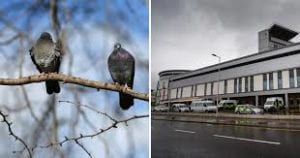Revival of the Passenger Pigeon? Not to be confused with the carrier pigeon (a domesticated bird trained to transport messages), the passenger pigeon is believed to have constituted 25 to 40 percent of the total U.S. bird population at one time. Its main nesting area was in the region of the Great Lakes and east to New York, where it relied on mixed hardwood forests to protect and sustain its massive flocks of up to 5 million birds at a time on a diet of beechnuts, acorns, chestnuts, seeds and berries, along with worms and insects in the spring and summer. Passenger pigeons built low-hanging, flimsy nests that often left eggs on the ground, but were able to successfully reproduce thanks to their sheer numbers: Predators such as raccoons, foxes, possums, hawks, eagles and snakes could gorge themselves on pigeon eggs without exhausting the supply.
This system, known as “predator satiation,” quickly broke down when humans became the species’ primary predator. Though humans had long used passenger pigeons for food to some extent, and farmers had killed them for causing damage to crops in such huge numbers, this didn’t reduce their numbers–until a mass slaughter by professional hunters began in the 1800s. Ironically, the birds were particularly vulnerable to such hunting because they nested in such large numbers. With no laws restricting the number of pigeons killed or the way they were taken, hunters placed baited traps or decoys, shot at nesting sites, knocked the birds out of their nests with long sticks or placed pots of burning sulphur under the trees so that fumes would daze the pigeons and cause them to drop out of their nests.
By the 1850s, hundreds of thousands of passenger pigeons were being killed for private consumption or sale, sometimes for as little as 50 cents a dozen. The cheap pigeon meat was fed to slaves, among others. By 1860, people noticed that the number of passenger pigeons had decreased, but no action was taken to stop the mass killing. Passenger pigeons had largely disappeared from American skies by the early 1890s, and the last known sighting in the wild occurred in 1900. “Martha,” the last known surviving passenger pigeon, lived all of her 29 years at the Cincinnati Zoological Society. After her death in 1914, she was frozen into a 300-pound block of ice and shipped to the Smithsonian Institution, where she was mounted for display as part of the museum’s bird collection, one of the largest in the world.
Now, nearly a century after Martha’s death, scientists believe they can bring her species back to life, using techniques worthy of the 1990s science-fiction/action blockbuster “Jurassic Park.” With funding from Revive and Restore, a group dedicated to the de-extinction of recently lost species, the young biologist Ben J. Novak is spearheading efforts to use DNA taken from passenger pigeon specimens in museums and fill it in with fragments from a living species, the band-tailed pigeon. The reconstituted genome would then be inserted into a band-tailed pigeon stem cell, creating a germ cell (an egg-and-sperm precursor). When the germ cell is injected into young band-tailed pigeons and these pigeons reproduce, their offspring would come as close as possible to expressing the passenger pigeon genes. The “de-extinction” process is different from cloning, in that it uses a variety of DNA from different passenger pigeons, meaning that the offspring produced would be as unique as any bird from an original passenger pigeon flock.
Most experts acknowledge that recreating the passenger pigeon in this way is technically possible, based on the success scientists have had mapping the woolly mammoth genome by using elephant DNA, among other experiments. But significant challenges still exist, particularly when it comes to reintroducing the passenger pigeon into the wild, given the vastly different ecosystem it would encounter in the modern world. Much of the bird’s breeding and wintering habitats are gone due to deforestation, and its primary breeding season food (beech mast, the nuts of a beech tree) now exists only in limited quantities. And with likely flocks of only a few thousand of the new pigeons (as opposed to 5 million) the species’ mass tactics of survival wouldn’t be able to protect them from predators.
Novak, for one, told the Washington Post that he believes people are sufficiently committed to the de-extinction of the passenger pigeon to overcome such obstacles. History may help his cause, as the extinction of the passenger pigeon did play a significant role in arousing public interest in the need for stronger conservation laws. In any case, only time will tell, as scientists estimate it will take at least a decade to produce a flock of new passenger pigeons large enough to release into the wild.
At Pigeon Patrol, we manufacture and offer a variety of bird deterrents, ranging from Ultra-flex Bird Spikes with UV protection, Bird Netting, 4-S Gel and the best Ultrasonic and audible sound devices on the market today.
Contact us at 1- 877– 4– NO-BIRD, (604) 585-9279 or visit our website at www.pigeonpatrol.ca
Bird Gone, Pigeon Gone, Seagull Gone, Pigeon issue, pigeon spikes, 1-877-4NO-BIRD, 4-S Gel, Bird Control, Pigeon Control, bird repellent, Bird Spikes, sonic bird repellent, stainless steel bird spikes, bird spikes Vancouver, Ultra Sonic Bird Control, Bird Netting, Plastic Bird Spikes, Canada bird spike deterrents, Pigeon Pests, B Gone Pigeon, Pigeon Patrol, pest controller, pest control operator, pest control technician, Pigeon Control Products, humane pigeon spikes, pigeon deterrents, pigeon traps, Pigeon repellents, Sound & Laser Deterrents, wildlife control, raccoon, skunk, squirrel deterrent, De-Fence Spikes, Dragons Den, Canada bird spikes, Canada pigeon, pigeon control, pigeon patrol, pigeon. Kill pigeons, crow, starling
